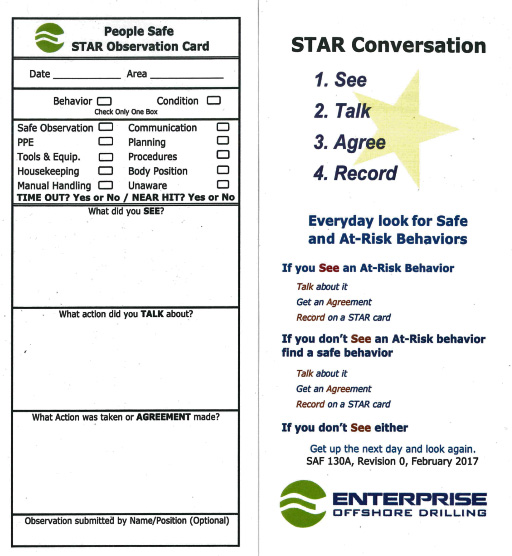The safety and welfare of our people is at the forefront of everything we do at “The People Company”. Incident Free Operations are a primary core value and returning our people home safely to their families is our primary objective.
Our behavioral-based safety training program, “PeopleSafe” is fundamental to our success. It’s not just a safety policy program, it’s a part of every job task.
POLICY STATEMENT
The objectives of our QHSE management system are to ensure safety at sea and all other work locations; prevention of ill-health, human injury, and loss of life and avoidance of damage or limited impact to the environment and to property. These objectives assist management in enhancing operational performance and reducing the probability and severity of safety and environmental incidents.
FOCUSED ON SAFETY
SEMS is BSEE's Safety and Environmental Management Systems ruling which requires that all operators submit performance measure data outlined in the Outer Continental Shelf (OCS) Performance Measures Program. BSEE notes that SEMS is a performance-focused tool for integrating and managing offshore operations and that the purpose of SEMS is to enhance the safety of operations by reducing the frequency and severity of accidents. We are in full compliance with BSEE’s four (4) principal SEMS objectives:
- Focus attention on the influences that human error and poor organization have on accidents;
- Continuous improvement in the offshore industry's safety and environmental records;
- Encourage the use of performance-based operating practices;
- Collaborate with industry in efforts that promote the public interests of offshore
PeopleSafe is our behavioral-based safety process. It requires all employees to be responsible for conducting structured health, safety, and environmental conversations in the workplace to eliminate at-risk behavior. All other non-employee team members involved in our operations are encouraged to participate. When an At-Risk behavior is observed, it is necessary to promptly talk about it, get an agreement, and then record the event on a STAR (See, Talk, Agree, Record) Observation Card. If an At-Risk behavior is not observed - find a safe behavior. STAR Card observations are shared and discussed with facility employees during their daily meetings.
SAFETY TOOLS EMPOWER US.
The Job Safety Analysis planning tool is a simple, organized approach to:
- Identify and discuss the job ahead; break it down into manageable steps; thoroughly identify the risks.
- Identify and discuss the hazards for each step; focus on the steps most likely to do us harm.
- Identify and discuss ways to manage the hazard with the most desirable precaution being complete elimination the hazard.
Time-Out empowers any person with the authority and responsibility to stop a job when any hazard is identified. Should any person on board our facility, perceive that a situation may be unsafe or otherwise hazardous in any way, that person is responsible for calling a Time-Out to interrupt the work process. Activity shall recommence only when a plan is implemented to mitigate the hazard.
The purpose of the Permit to Work is to ensure compliance with mandatory controls when performing potentially hazardous and high-risk work. The permit authorizes and highlights that appropriate health, safety, quality, operational, training, emergency response, environmental procedures and equipment are used. A written permit is prepared, discussed and approved by the Offshore Installation Manager (OIM) and the process is monitored and managed until the permitted work is properly completed.

